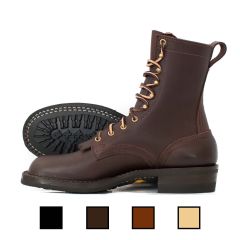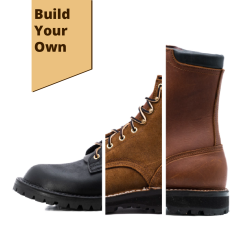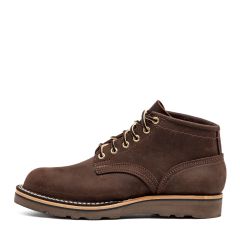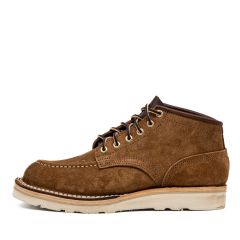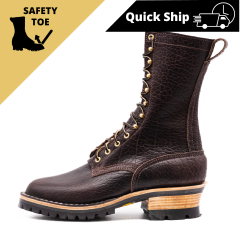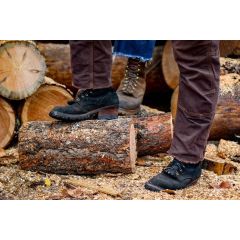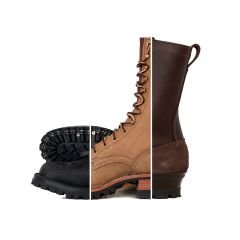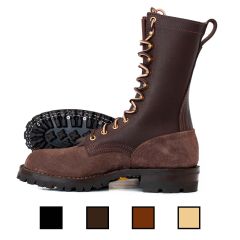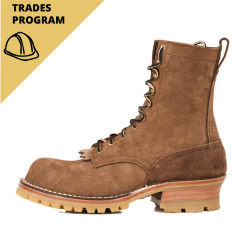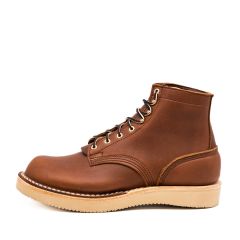Leather Boots For Welding
Leather Boots For Welding: Safety At Its Best
Durable Protection
Crafted from high-quality leather, welding boots resist sparks and hot metal splatters, providing heat resistance and protection against sharp objects. The robust nature of high-quality leather used in welding boots not only offers excellent resistance to the high temperatures and abrasive conditions found in welding environments but also ensures that the boots remain intact and protective over extended periods of use.
This long-term durability makes them a cost-effective choice, as their ability to withstand daily wear and tear means fewer replacements and less downtime due to damaged or inadequate footwear.
Enhanced Safety Features
Steel toes protect against heavy falling objects. They are also slip-resistant and electrically insulating soles safeguard against potential hazards. The high-cut design and metatarsal guards offer additional protection from burns and impacts.
Essential Gear For Welders
Welding boots are a crucial piece of safety equipment, providing protection against heat, punctures, electrical hazards, and impacts. Choosing the right pair ensures welders can work safely and effectively in any welding environment.
The Importance Of Choosing The Right Footwear For Welding
- Selecting the correct footwear for welding is crucial for safety, not just comfort.
- Leather boots offer protection against hazards like heat, sparks, and molten metal.
- Insulating soles in welding boots help prevent electric shock.
- Steel-toe caps and puncture-resistant soles protect against crushing and puncture injuries.
- Quality welding footwear provides stability and slip resistance on slippery surfaces.
- Choosing the right welding boots is essential for a welder's safety and career longevity.
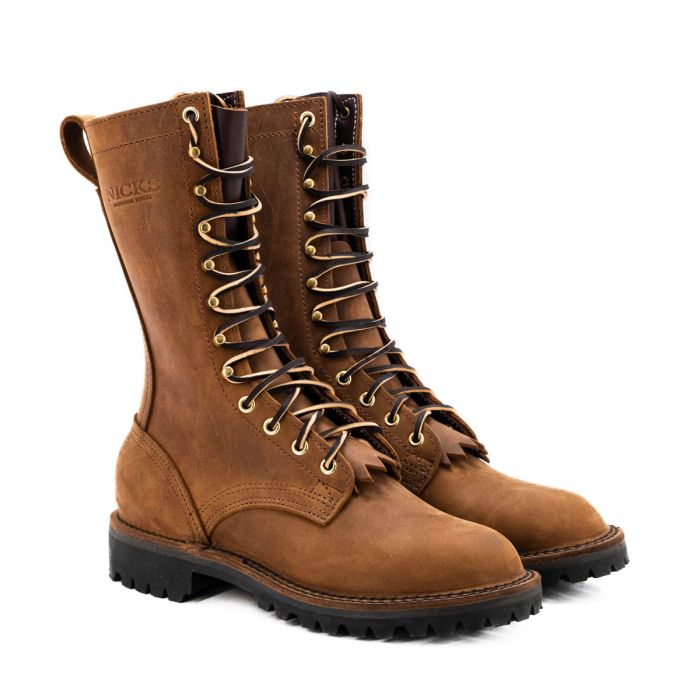
Key Features Of High-Quality Leather Welding Boots
When looking for top-notch leather welding boots, it's essential to consider the following key features:
- Heat-Resistant Leather Material: Quality welding boots use treated leather to withstand intense heat for prolonged durability and protection.
- Steel Toe Caps: Boots with steel toe caps offer vital toe protection from heavy objects, meeting safety standards for impact resistance.
- Metatarsal Guards: These guards provide extra protection for the upper foot, crucial for welders working with heavy materials or in high-risk environments.
- Puncture-Resistant Soles: Premium boots feature soles that resist punctures, ensuring protection from sharp objects on the ground.
- Slip-Resistant Outsoles: Boots with slip-resistant outsoles provide stability and traction on various surfaces to prevent slips and falls.
- Electrical Hazard Protection: Boots with electrical hazard (EH) protection safeguard against electrical shocks by using non-conductive materials.
- Ankle Support And Comfort Features: Comfort is key for long welding hours, so look for boots with padded collars, supportive midsoles, and ergonomic insoles to reduce fatigue and prevent injuries.
Benefits Of Leather Boots In Welding Applications
Superior Durability And Protection
Enhanced Heat Resistance are durable and offer excellent protection against welding hazards such as sparks and splatters of molten metal, preventing burns and injuries. The robust construction and thoughtful design of these boots make them a reliable choice for welders who require footwear that can withstand the demanding environment of their work while keeping their feet secure from burns and other injuries.
Enhanced Heat Resistance
Leather boots are not only durable but also naturally insulating, making them ideal for environments where exposure to high temperatures is common, such as in welding operations. This material can withstand the sparks and spatter of welding, safeguarding the wearer against burns and other heat-related injuries. By choosing leather boots, welders ensure an added layer of safety, allowing them to focus on their work with confidence in their protective gear.
Electrical Hazard Protection
Many leather welding boots are designed with electrical hazard (EH) protection, incorporating non-conductive materials in the sole and heel to reduce the risk of electrical shocks. This feature is particularly important in welding environments where the likelihood of encountering live electrical circuits is higher. By wearing boots equipped with EH protection, welders can work more safely around electricity, knowing they have an added layer of defense against potential electrical hazards.
Prevention Of Punctures And Cutting Injuries
Thick and puncture-resistant soles are engineered to provide a robust barrier between the foot and potential hazards, such as nails, scrap metal, and sharp debris, commonly encountered in workshops and on sites. This feature significantly lowers the risk of puncture wounds or injuries, allowing workers to move around with confidence. Additionally, these soles often come with added layers of protection and are made from materials specifically designed to resist penetration, further enhancing safety in environments where sharp objects are a frequent concern.
Comfort And Ergonomic Support
The inclusion of padded insoles and ergonomic support in leather welding boots not only provides comfort but also aligns and supports the foot in a natural position, minimizing stress on joints and muscles during long hours of standing or walking. Breathable linings facilitate air circulation within the boot, preventing moisture buildup and keeping feet dry, further reducing the risk of blisters and fungal infections. This combination of features ensures that welders can concentrate on their work without distraction from discomfort, promoting overall well-being and productivity on the job.
Long-Term Cost Effectiveness
Leather welding boots, with their superior durability and comprehensive protective features, represent a wise investment for anyone in the welding field. The high-quality materials and construction mean these boots can withstand the rigorous demands of welding environments, from extreme heat to sharp objects, significantly outlasting cheaper alternatives. This extended lifespan not only reduces the need for frequent replacements but also ensures continuous protection and comfort, making them a cost-effective choice for professionals looking for long-term reliability in their protective footwear.

How Leather Boots Protect Welders From Hazards
Among the array of safety equipment, Nicks Boots leather boots can play a pivotal role in shielding welders from these occupational hazards. Let’s explore how these specialized boots provide comprehensive protection.
Heat And Fire Resistance
Leather is inherently resistant to heat, making it an excellent material for welding boots. The thick, durable nature of leather acts as a barrier against the extreme temperatures encountered in welding, effectively preventing burns from hot metal and sparks. Additionally, high-quality leather boots are often treated with fire-retardant chemicals, enhancing their ability to resist ignition and protect the feet from flames.
Protection From Electrical Hazards
Electrical shocks are a serious risk in welding jobs, especially in environments where electrical circuits may not be adequately insulated. Leather boots for welding are often designed with electrical hazard (EH) protection in mind. This means the soles are made from materials that do not conduct electricity, providing an extra layer of safety against electrical shocks, thereby significantly reducing the risk of electrocution for the welder.
Resistance To Punctures
The floors of workshops and construction sites where welding takes place are frequently littered with sharp objects that could easily penetrate standard footwear, leading to foot injuries. Leather boots for welding are fortified with thick, puncture-resistant soles, made from materials such as steel or a heavy-duty polymer. This feature ensures that even if a welder steps on a sharp object, their feet are well-protected against punctures.
Support And Stability
Welding often requires working in awkward positions or standing for extended periods, which can strain the feet and ankles. Leather boots provide crucial support and stability, thanks to their robust construction and ergonomic design. Features such as reinforced ankle support help reduce the risk of injury from slips, trips, or falls, while also mitigating fatigue during long working hours.
Encasing The Foot In Safety
Beyond the sole and material, the overall design of leather welding boots encases the foot in safety. The high-top style not only protects the ankle but also prevents sparks or hot metal from entering the boot. Certain designs include additional protective features such as metatarsal guards that shield the top of the foot from heavy impacts and heat.
Minimizing Slips, Trips, And Falls
Accidents such as slips, trips, and falls can lead to severe injuries. This is particularly true in welding environments where oil, water, or metal scraps may create hazardous conditions. The outsoles of leather welding boots are designed to be slip-resistant, providing a firm grip on various surfaces and preventing accidents before they happen.
In crafting leather boots for welders, every detail is meticulously designed to address the multifaceted dangers present in welding environments. From resisting extreme heat and electrical hazards to providing physical support and preventing punctures, these boots are an essential component of a welder's protective gear arsenal. The well-being of the welder remains at the forefront of the design, ensuring that every step taken in the demanding world of welding is a step taken in safety.
Frequently Asked Questions
What are leather welding boots used for?
Leather welding boots are specifically designed to protect welders' feet from hazards such as sparks, spatter, and heat generated during welding processes. They also offer protection against electrical shocks, slips, and sharp objects.
How do leather boots protect welders?
Leather boots protect welders by providing a durable barrier against the intense heat, sharp objects, and electrical hazards of welding environments. High-quality leather is naturally resistant to sparks and minor spatters, and many boots are designed with additional linings and insulating materials for extra protection.
What features should I look for in leather welding boots?
When looking for leather welding boots, prioritize features such as flame-resistant materials, steel toe caps for impact protection, electrical hazard ratings, slip-resistant soles, and comfortable, breathable linings. Ankle support and quick and easy donning and doffing capabilities can also be beneficial.
Are all leather boots suitable for welding?
Not all leather boots are suitable for welding. Only those specially designed with safety features relevant to welding tasks ensure adequate protection. Regular leather boots may not offer sufficient protection against the specific hazards present in welding environments.
How do I maintain leather welding boots?
Maintain leather welding boots by cleaning them regularly to remove contaminants, applying leather conditioner to keep the material supple, drying them out properly if they become wet, and inspecting them for damage or wear and tear. Proper maintenance can significantly extend their life.
How long can leather welding boots last?
The lifespan of leather welding boots varies depending on the quality of their construction, the harshness of the welding environment, and how well they are maintained. With proper care, high-quality boots can last several years, even in demanding conditions.
Can leather welding boots withstand sparks and spatter?
Yes, high-quality leather welding boots are designed to withstand exposure to sparks and spatter. They're made from materials that can resist the heat and potentially damaging effects of welding spatter, though they are not indestructible and will show wear over time.
What's the difference between welding boots and regular work boots?
Welding boots are specifically designed to address the unique dangers associated with welding, such as higher temperatures, sparks, spatter, and electrical hazards. They have features like flame-resistant materials, steel toe caps, and electrical resistance not always found in regular work boots.
Do leather welding boots come with toe protection?
Yes, most leather welding boots come equipped with steel toe caps or composite materials for toe protection. This feature protects the feet from heavy falling objects and compression accidents common in welding and industrial environments.
How do I ensure a proper fit for welding boots?
To ensure a proper fit for welding boots, measure your feet later in the day when they are largest, wear the socks you plan to use while welding, and try on boots from different manufacturers as sizing can vary. Look for boots that offer support and comfort without being too tight or too loose, allowing for natural movement and circulation.
